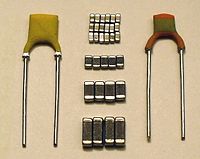
Cold‐Sintered C0G Multilayer Ceramic Capacitors
Sign Up to like & getrecommendations! Published in 2019 at "Advanced Electronic Materials"
DOI: 10.1002/aelm.201900025
Abstract: Multilayer ceramic capacitors (MLCCs) based on (Bi0.95Li0.05)(V0.9Mo0.1)O4‐Na2Mo2O7 (BLVMO‐NMO), with er = 39, temperature coefficient of capacitance, TCC ≈ ±0.01%, and tan δ = 0.01 at 1 MHz, are successfully fabricated by a cold‐sintering process at… read more here.
Keywords: ceramic capacitors; sintered c0g; c0g multilayer; multilayer ceramic ... See more keywords

Balanced development of dielectric permittivity, loss tangent, and temperature stability in K0.5Na0.5NbO3-based ceramic capacitors
Sign Up to like & getrecommendations! Published in 2020 at "Journal of Alloys and Compounds"
DOI: 10.1016/j.jallcom.2019.152798
Abstract: Abstract Ceramic capacitors are extremely expected to attain the high dielectric permittivity (e′) and low loss tangent (tanδ) stabilized in an ultra-wide operating temperature range. In this work, we improved e′, tanδ and their temperature… read more here.
Keywords: ceramic capacitors; loss tangent; temperature; dielectric permittivity ... See more keywords

Effects of dielectric thickness on energy storage properties of surface modified BaTiO3 multilayer ceramic capacitors
Sign Up to like & getrecommendations! Published in 2020 at "Journal of Alloys and Compounds"
DOI: 10.1016/j.jallcom.2019.152804
Abstract: Abstract Surface modified BaTiO3 were synthesized by coating BaTiO3 particles of 50/230 nm average grain size with 3 wt% Al2O3 and 1 wt% SiO2 (BTAS5/BTAS1). Multilayer ceramic capacitors (MLCC) were fabricated via two-steps sintering method. After sintering, average… read more here.
Keywords: ceramic capacitors; energy; surface modified; modified batio3 ... See more keywords

Electric field enhancement in ceramic capacitors due to interface amplitude roughness
Sign Up to like & getrecommendations! Published in 2019 at "Journal of the European Ceramic Society"
DOI: 10.1016/j.jeurceramsoc.2018.10.033
Abstract: Abstract The electrical behaviour of the interface between the ceramic and electrode layers in multi layer ceramic capacitors has been studied using finite element modelling. Interface models were produced with varying amplitudes of roughness based… read more here.
Keywords: field; ceramic capacitors; electric field; field enhancement ... See more keywords

High energy-storage performance of PLZS antiferroelectric multilayer ceramic capacitors
Sign Up to like & getrecommendations! Published in 2020 at "Inorganic chemistry frontiers"
DOI: 10.1039/c9qi01416k
Abstract: Multilayer ceramic capacitors in energy-storage applications have received increasing attention due to the advantages of high power density, low drive voltage and fast charge/discharge rates. However, the low energy density is a great challenge which… read more here.
Keywords: ceramic capacitors; high energy; multilayer ceramic; energy storage ... See more keywords

High-temperature lead-free multilayer ceramic capacitors with ultrahigh energy density and efficiency fabricated via two-step sintering
Sign Up to like & getrecommendations! Published in 2019 at "Journal of Materials Chemistry A"
DOI: 10.1039/c9ta04317a
Abstract: A fast heating assisted two-step sintering method is developed to fabricate multilayer ceramic capacitors with ultrahigh energy-storage density and efficiency. read more here.
Keywords: two step; step sintering; multilayer ceramic; ceramic capacitors ... See more keywords

Acoustic Phenomena in Damaged Ceramic Capacitors
Sign Up to like & getrecommendations! Published in 2018 at "IEEE Transactions on Industrial Electronics"
DOI: 10.1109/tie.2017.2714123
Abstract: Multilayer ceramic capacitors are prone to mechanical defects and damage because of the fragility of the ceramic dielectric. Because these faults are often not recognized by visual or electrical inspection, a nondestructive fast way of… read more here.
Keywords: ceramic capacitors; acoustic phenomena; phenomena damaged; damaged ceramic ... See more keywords

Reliability of X7R Multilayer Ceramic Capacitors During High Accelerated Life Testing (HALT)
Sign Up to like & getrecommendations! Published in 2018 at "Materials"
DOI: 10.3390/ma11101900
Abstract: Multilayer ceramic capacitors (MLCC) are essential components for determining the reliability of electronic components in terms of time to failure. It is known that the reliability of MLCCs depends on their composition, processing, and operating… read more here.
Keywords: ceramic capacitors; multilayer ceramic; accelerated life; reliability ... See more keywords

Mixed Solvents in Multilayer Ceramic Capacitors (MLCC) Electronic Paste and Their Effects on the Properties of Organic Vehicle
Sign Up to like & getrecommendations! Published in 2022 at "Polymers"
DOI: 10.3390/polym14040685
Abstract: The copper end paste used in multilayer ceramic capacitors sintered in nitrogen atmosphere leads to carbon residues of organic vehicles, which leads to a reduction in electrode conductivity and high scrap rate. With an attempt… read more here.
Keywords: organic vehicles; ceramic capacitors; multilayer ceramic; mixed solvents ... See more keywords